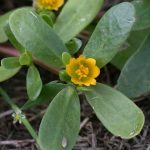Portulaca oleracea or purslane or Cow’s palate or Dááɓùrín sáánìyáá or Gure or Hárshèn rààgòò or Rùb dà túkúnyá or Báábáá jíbjíí (Hausa): A nutritionally beneficial plant with many Hausa names
Occurrence and Description
Portulaca oleracea is s cosmopolitan species and the genus Portulaca belongs to the family Portulacaceae, a small family with 21 genera and 580 species, and is cosmopolitan in distribution, occurring especially in America with some species found in Arabia. Purslane plants are succulent, annual herbaceous, and erect or decumbent up to 30 cm high. There are 3 varieties of purslane, namely, the green, golden, and a large-leaved golden. Purslane deserves special attention from agriculturalists, food scientists, dietitians and nutritionists. Purslane is a common weed in turfgrass areas as well as in field crops.
Many varieties of purslane under many names grow in a wide range of climates and regions. Purslane has wide acceptability as a potherb in Central Europe, Asia, and the Mediterranean region. It can be found in Europe, Africa, North America, Australia, and Asia. It is an important component of green salad and its soft stem and leaves are used raw, alone, or with other greens.
Nutritional value and health benefits of Portulaca oleracea
Purslane is also used for cooking or used as a pickle. Its medicinal value is evident from its use for treatment of burns, headache, and diseases related to the intestine, liver, stomach, cough, shortness of breath, and arthritis. Its use as a purgative, cardiac tonic, emollient, muscle relaxant, and anti-inflammatory and diuretic treatment makes it important in herbal medicine. Purslane has also been used in the treatment of osteoporosis and psoriasis.
Recent research demonstrates that purslane has better nutritional quality than the major cultivated vegetables, with higher beta-carotene, ascorbic acid, and alpha-linolenic acid. Purslane has recently been identified as the richest vegetable source of alpha-linolenic acid, an essential fatty acid that belongs to the omega-3 fatty acids family.
Alpha-linolenic acid has been shown to lower cholesterol and triglyceride levels, but raise the concentration of the beneficial high density lipoprotein (good cholesterol).

Credit: Minnesota Wildlife
Moreover, the ability of omega-3 fatty acids to decrease the thickness of blood may be advantageous in the treatment of vascular diseases. One hundred grams of fresh purslane leaves (one serving) contains about 300-400 mg of alpha-linolenic acid, 12.2 mg of alpha-tocopherol (vitamin E, which is ~90% of the daily value), 26.6 mg of ascorbic acid (~30% of daily value), 1.9 mg of beta-carotene and 14.8mg of glutathione.
Purslane has been found to be the richest source of gamma-linolenic acid (4 mg/g fresh weight) of any green leafy vegetables. Gamma-linolenic acid plays an important role in the prevention and treatment of allergies, psoriasis and other inflammatory conditions.
Vitamin C and beta-carotene present in purslane have been reported to possess antioxidant activity, because of their ability to neutralize free radicals, and have the potential to prevent cardiovascular disease and cancer. Additionally, purslane has been described as a power food because of its high nutritive and antioxidant properties.
Purslane is a rich source of some minerals and vitamins. 100 grams of purslane provides 494 mg potassium, 68 mg magnesium, 65 mg calcium, 44 mg phosphorus and about 2 mg iron. Different varieties, harvesting times, and environmental conditions can contribute to purslane’s nutritional composition and benefits. Purslane is popular as a traditional medicine in China for the treatment of hypertension and diabetes. Scientifically, its anti-diabetic effects have not been proven, but still people use it for this purpose.
These are the thoughts of:
Sa’eed Halilu Bawa
Senior Lecturer (Associate Professor) at University of the West Indies, St. Augustine Campus, Trinidad.
Studied Food and Nutrition Sciences, Dietetics at Kaduna Polytechnic, Nigeria; Warsaw University of Life Sciences, Poland.
























